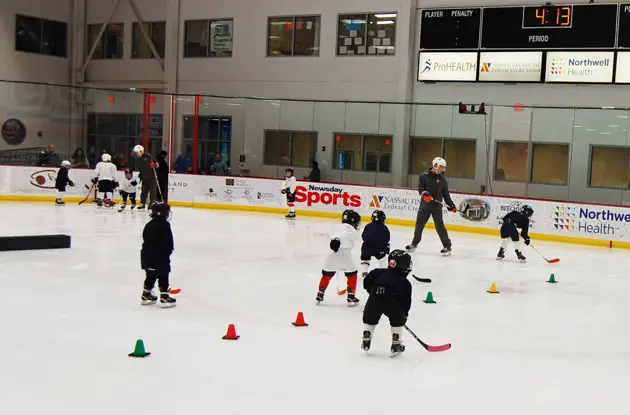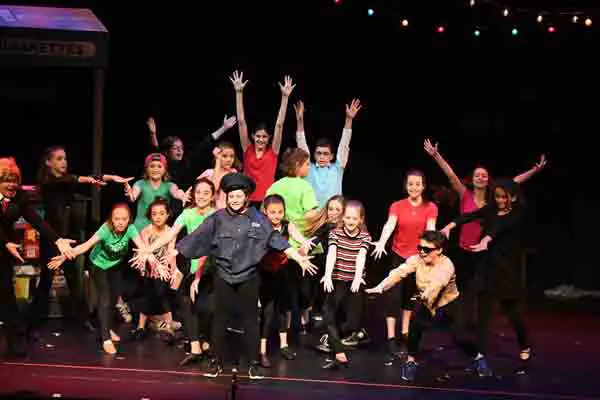From kung fu to tae kwon do to karate, martial arts have many benefits and great appeal for kids. Here’s what you need to know before you enroll your little ninja.
Nine-year-old Sam Schatzberg of Montvale, NJ often starts conversations by announcing that he’s a brown belt in karate. Sam, along with his younger sister Emma (8), started taking martial arts classes a few years ago at the Workout Place in Bardonia, and he fell in love with the sport right away, says mom Terri Schatzberg. “It’s definitely a part of who he is,” she says. “We joke that he’s going to own the karate studio when he grows up.”
Sam has cerebral palsy, which means exercise is especially important for him, but it’s also difficult to come by because he’s unable to keep up with other kids his age in team sports such as soccer. “He would normally go for physical therapy, but we use karate as therapy,” Schatzberg says. “It’s helped him with balance and movements. When he first started he couldn’t stand on one foot, and now he’s doing turning spins.”
Martial arts, traditional systems of combat and self-defense that originated in East Asia and are now practiced worldwide, have been around for centuries, but the sport enjoyed a mainstream heyday in the U.S. from about the mid-’80s to the early ’90s with the popularity of children’s games like Mortal Kombat and film series like Teenage Mutant Ninja Turtles, 3 Ninjas, and, of course, The Karate Kid. The latter was remade in 2010, and last year saw the release of Kung Fu Panda 2 and the new martial arts-inspired Disney series Kickin’ It, indicating that the sport hasn’t lost its appeal among the junior set. Whether it’s karate, kung fu, tae kwon do, or any of the various martial arts, practicing these centuries-old art forms has many benefits for kids-with special needs and without-beyond basic self-defense.
The Benefits
If you’ve ever seen The Karate Kid, you know practicing martial arts is more than just a sport. According to a 2004 study in The Sport Journal, published by the United States Sports Academy, martial arts can help kids improve their physical fitness, including coordination, flexibility, and strength, but the practice can also help reinforce some of life’s valuable lessons, such as perseverance and self-control.
“When people think of karate, they think of fighting and self-defense, and you are learning self-defense, but I think it’s really about learning responsibility, respect, discipline, and how to control yourself,” Schatzberg says.
Her children’s instructor, Arnold van Deuren, Ph.D., owner of the Workout Place and an adjunct professor of anatomy and physiology at Dominican College in Orangeburg, agrees with Schatzberg and adds that practicing martial arts also helps prepare kids for success in school. “As an educator for the last 40 years, I see it as a classroom situation,” he says. Karate gives kids a chance to work for belts. They have to learn a curriculum, prepare for and take a test, then use the analysis of their test results as a basis for continued improvement. “The process builds self-esteem and confidence and contributes to a child’s willingness to participate in further learning.” Additionally, van Deuren says, karate helps kids develop listening and attention skills that are essential in the classroom and beyond.
Kim Gold, a martial arts and yoga instructor at Aikido Westchester in White Plains, says martial arts has benefitted her two daughters, ages 8 and 12, in different ways. Her younger daughter, who has ADHD, has been training since she was 5 years old. “Martial arts has helped with her focus and her ability to handle frustrating situations,” Gold says, adding that patience and focus are two main tenets of Aikido Westchester’s youth program, which places particular emphasis on helping kids apply what they’re learning in martial arts to their schoolwork. The sport has also been a positive thing for Gold’s older daughter. “She’s developed a lot of confidence, especially when dealing with boys on the bus. She stands up for herself. She’s a skinny little girl, but she has a lot of confidence when she says ‘Take your hands off my friend.’ That comes from her training.”
Finding Mr. Miyagi
While traditional martial arts can hold many benefits for children, van Deuren says, they don’t glean these benefits from the sport itself, but from a good instructor. “There’s nothing inherently special about martial arts,” he notes. “It’s a good form of exercise. But what kids get out of it all depends on the instructor and his or her philosophical bent and training.”
Finding the right teacher is the most important step before starting your child in martial arts because this person (whom your child will most likely be calling “Master,” keep in mind) can have a marked influence on your child’s physical, emotional, and mental health, not to mention his manners. Because martial arts schools and teachers are not regulated by any governing body and do not require accreditation, it’s important to be wary and do some legwork:
Ask around. When Sam and Emma told her they wanted to do karate, Schatzberg immediately brought them to van Deuren because a family member had had a great experience at his studio. “My niece, who’s now 18, went to him. I knew his background and heard he was great with kids. Then I saw how he was with my children, and I knew it was the right fit.”
Check out a class. Sit in on a class and get a feel for the culture of the school. “You should carefully watch how the instructor is interacting with the children,” Gold says. “How do they handle a discipline problem? Are they losing their patience? That’s a red flag.” Gold adds that parents should also watch how the school’s students interact with each other, noting any bullying or violent behavior.
Talk to the teacher. Make sure the instructor has his or her priorities in order. Ask specific questions about approach to teaching and if he/she trains in the art. “It’s really important that teachers actually train on a regular basis because they’re teaching from their own practice,” Gold explains.
“The primary thing is to pay attention to the energy and culture of the classroom,” van Deuren concludes. “Martial arts should be taught in a safe, responsible way with attention to good values and an emphasis on a healthy, safe workout.”
While your child learns how to kick butt in tae kwon do classes, why not indugle in a workout for yourself? Check out Susan Chung’s new express workouts for grown-ups at Bruce Chung Tae Kwon Do and Family Fitness in Harrison. Chung, an accomplished sixth degree Master of Tae Kwon Do and co-owner of the study, leads a new efficient full body work out from 1-1:40pm on Mondays and Fridays.





















